Just like humans who hurt their back, physical therapy for dogs with spine problems can be a huge benefit. It can increase mobility, improve strength, and maintain overall health. There’s physical therapy for a dog’s hind legs, core, and balance. Canine rehab can be done in a clinic setting and there are dog physical therapy exercises you can do at home. Both can be a big advantage to your dog’s well-being.
Table of Contents[Hide][Show]
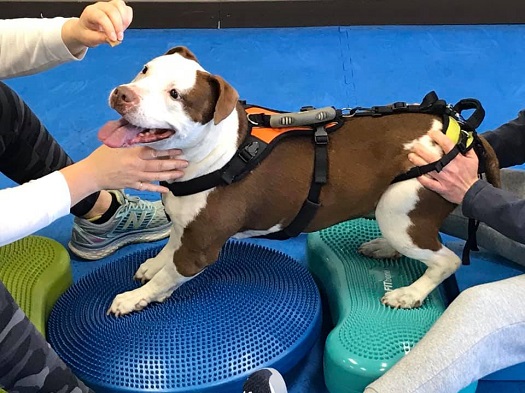
My city didn’t have a canine physical therapist when my dog, Sophie, started to have weakness in her hind legs. I think this is true for many pet families.
To help, I spent hours researching exercises Sophie and I could do together and I’ve included instructions for each of them in this article. They’re all routine rehab and massage techniques prescribed by veterinarians and canine PTs to improve conditions that range from arthritis to disc disease and neurological disorders.
They’re easy to learn and most dogs will like the time they spend doing them with you. That said, be sure to check with your vet before starting the exercises.
Note: Every case of spine disease or injury is unique. Your dog’s vet will know whether or not your pup can tolerate the exercises below. Please get the okay before starting. And remember to stop any exercise that’s painful for your dog. (This post contains some affiliate links.)

Ask & Discover
Get personalized content recommendations and answers drawn from our website. Simply type your question or topic of interest, and our AI assistant will help you find relevant articles, tips, and insights. You can also have a natural conversation to explore topics in more depth.
Spinal conditions that respond well to physical therapy
The list of spine conditions that benefit from rehab exercise is long. These are the most common:
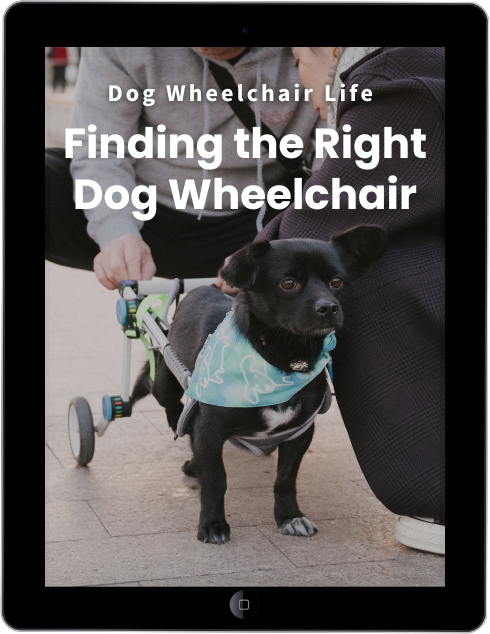
eBook
Find The Right Dog Wheelchair For Your Pet
Your dog has a mobility problem, and you want to buy a wheelchair. But do you know what kind of cart will work best for your dog’s individual needs? After a decade of teaching pet owners how to make the right choice, I put the information into an eBook!
When your dog first comes home from the hospital

Laurie Edge-Hughes, BScPT, MAnimSt, CAFCI, CCRT is a world-renowned canine physical therapist. She wrote the course that teaches health professionals how to become a PT for dogs.
Her recommendation for when your dog comes home from the hospital after spine surgery, an IVDD episode, or FCE stroke is to take it slow.
“Your job is to provide basic nursing care,” said Laurie. “This includes the prevention of pressure sores by moving them every 4 hours and gently washing them daily with a warm wet towel to prevent urine scald.”
Any physical therapy should be limited to lightly stimulating their limbs.
Dog physical therapy exercises to do during the early stages of recovery
Many dogs are confined to crate rest during the first 3 to 4 weeks after coming home. Below are gentle exercises for that period.
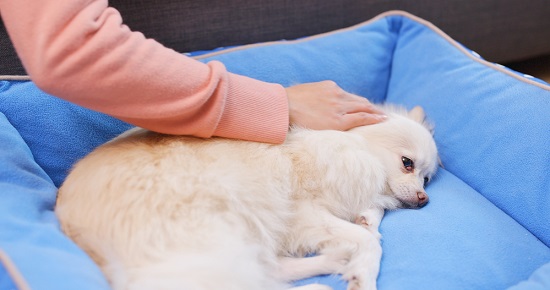
Massage
Toe Squeeze

Get the Essential Guide
The Essential Guide of Products for Handicapped Dogs e-book is a labor of love for me. I wrote it to answer your most pressing questions about where to find the best products for your wheelchair dog. You’ll find products you didn’t know existed and each will improve your dog’s quality of life. Print a copy and keep it by your side.
Rehab exercises after 3 to 4 weeks of crate rest
*Be sure to get your vet’s approval before starting these exercises.
Laurie’s recommendation to pet parents is to NOT have a strict physical therapy schedule.
“I recommend pet owners throw exercise and rehab into their regular daily routine. If you’re watching TV, include range-of-motion exercises or roll them from side to side. This makes exercise fun and relaxing for you and your dog.”
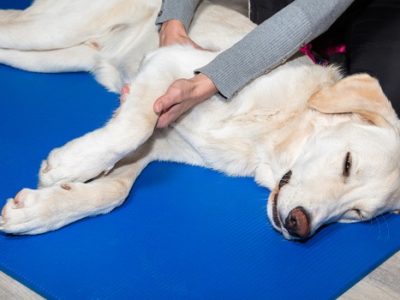
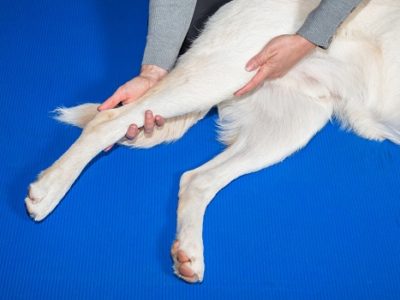
Passive Range of Motion (PROM)
Strength Training
Physical therapy exercises for dogs who can stand or almost stand
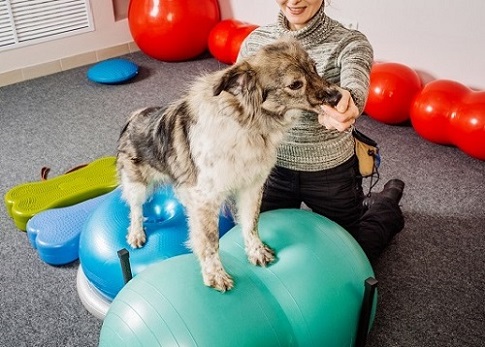
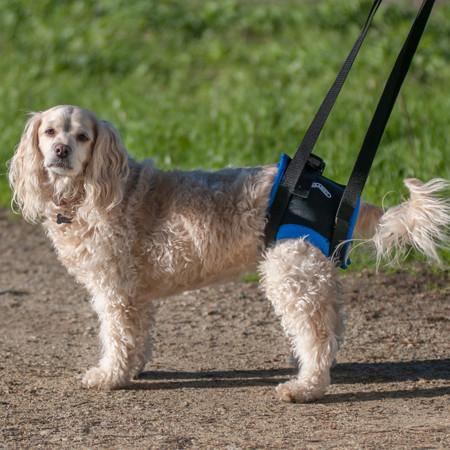
My favorite harnesses for disabled dogs.
Stand and Count
Stand and Shift Weight
Sit and Stand
Tail Pinch
Heads Up
Here’s a video of dog physical therapy exercises you can do at home.
Don’t forget about playtime
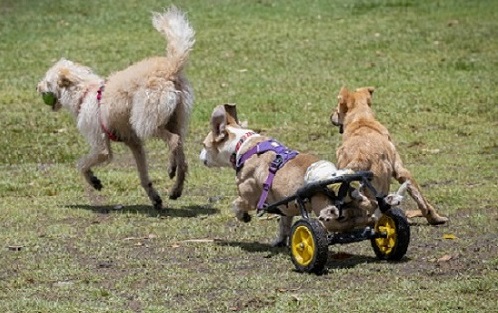
Go outside
When your dog is released from crate rest, be sure to take them outdoors. It doesn’t matter if they walk with a dog wheelchair, a harness, use a stroller, or scoot around – dogs love spending time outside. The fresh air, playtime, and spending an hour cruising their neighborhood can be the best medicine for a disabled pooch.
If your dog’s in a wheelchair or harness, practice walking on different terrains. Change from a flat surface to one with a slight slope or walk on the grass and then the sidewalk. Each surface helps your dog with balance.
Being outdoors is mentally stimulating and fun for your pup, so make the walk casual and stress free. Walking also increases a dog’s appetite and improves digestion. So, grab your shoes, put your pup in their cart, and go for a walk.
One final reminder
The exercises in this story are general recommendations. Many dogs won’t be able to accomplish all of them, but that’s okay. Spine disease and paralysis in dogs is unique to every patient. Some dogs regain mobility and many do not.
If possible, have your veterinarian or a licensed canine physical therapist approve a list of rehab exercises appropriate for your individual pet.
And please keep in mind that your dog can have a happy life whether or not they will walk again.
Cover photo – Thank you to pet Mom Jen Z. for sharing this picture of Josie, her paralyzed dog, doing physical therapy on a balance ball.
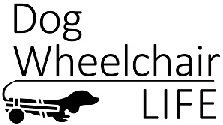

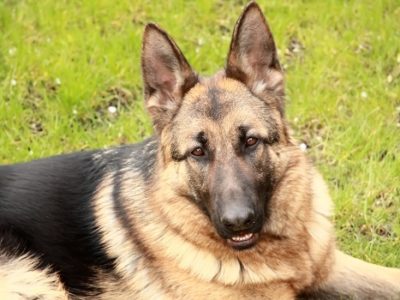

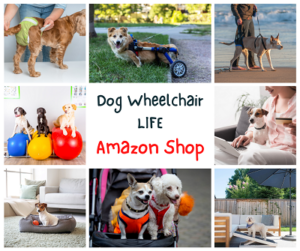
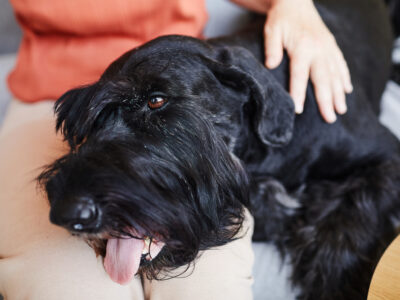
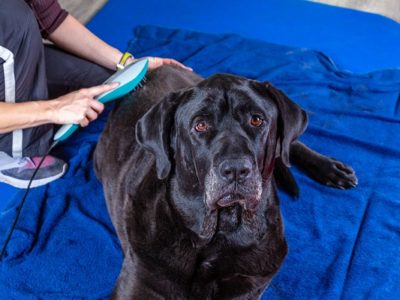
Jewels (Dachs, 4 yrs) had IVDD surgery 5/12/2021 has no real balance or walking ability in her hind legs. So far she has not taken to much to the wheelchair, but likes the sling under her belly. She has developed touch sensation in her both feet as well as kicking ( ie almost like swimming), slightly greater in the left hind leg. I nightly put her in her life-jacket and in the hot tube we go for 20-30 minutes of motion and stimulated kicking from the jets which she seems to enjoy (temp at 94 degrees).
What exercises would you recommend for the hydrotherapy sessions as well as all that’s in the short video.
Respectfully
Steve
Hi Steven, It sounds like you and Jewels are on the right track. It’s very good news that she has feeling in her hind legs. Regarding exercises for your hydrotherapy sessions, here’s a link to a story about hydrotherapy on the website: https://dogwheelchairlife.com/why-hydrotherapy-for-dogs-is-quickly-gaining-popularity/ It gives you specific ideas about what to do in the water. I recommend that you pay close attention to the “twiddling” of the tail. It encourages sensations in the legs. You’ve accomplished a lot with Jewels in a short time. I hope she continues to heal. – Sharon
Hi Sharon
My 4 year old dachshund, Ella , was given a prognosis of ivdd. We were sent home with nsaids and a muscle relaxer and plenty of rest. She is eager to move, but unfortunately has no movement in her hind legs. What Do you recommend my first steps in at home therapy be ?
Kristian
Hi Kris, I’m sorry to hear about Ella. IVDD is a scary diagnosis, but most dogs do very well with the disease whether they’re able to walk again or not. The website has a section dedicated to IVDD. It’s a common disease, but it’s also one we know a lot about. I hope you’ll check out the articles. Here’s the link: https://dogwheelchairlife.com/category/ivdd/ For now, it sounds like your vet has ordered crate rest. Did he say how long Ella should rest? You might also ask if you can start doing some of the basic PT exercises I share my article. Usually you will be able to start range of motion exercises pretty early in the recovery or the pinch the toes and twiddling the tail. All of them keep blood flowing to the area and stimulate the nerves. Please talk with your vet about a plan like this. -Sharon
Hi
My Sydney a labradoodle, had his hind right leg amputated in March 21, after having a hip replacement being dislocated.
He was doing really well once he recovered from surgery, however, he’s really struggling now. We can only walk to the end of the street, his remaining leg gives way more often than before, he struggles when getting up or lying down too. I
I’ve booked him in for hydrotherapy locally, but wondering if there’s any physio exercise I can do at home with him.
Hi Marilyn, I’m sorry to hear about Sydney’s amputation. I am not a veterinarian, so please talk to your vet before you do the exercises I’m suggesting with your dog. A lot depends on his overall health and other health problems.
That said, if you refer back to my article 9 Dog Physical Therapy Exercises You Can Do At Home, https://dogwheelchairlife.com/9-dog-physical-therapy-exercises-you-can-do-at-home/, you might want to try Passive Range of Motion to keep his hind and front limbs flexible, along with some strength training like the Stand and Shift Weight and the Sit and Stand. You might also want to try a balance ball for Sydney’s front limbs. They actually carry the majority of the weight for walking and running than the rear legs. Again, please ask your vet about this. I also highly recommend that you look a the Tripawds website. It’s strictly for dogs with an amputation. I found this page with a video on their website: https://tripawds.com that might be helpful for you. https://tripawds.com/2010/02/19/canine-rehabilitation-exercises-and-stretches-with-care/ Good luck with hydrotherapy. I bet Sydney will love it. – Sharon
On 12/22/20 my 7 year old Labradoodle was diagnosed with congestive myelopathy due to intervertebral disc disease. She underwent a right sided Hemilaminectomy on 12/23/20 and was sent home on 12/26/20. She started hydrotherapy (2xweek) in early January in Ballwin, MO; we added laser in March (Glen Carbon, IL). She is now walking on her own (no sling) through the house, around the neighborhood, and romping in the backyard with lots of additional rehab at home. However, now she has loss of muscle mass in her hind legs. Please suggest what we should do now – continue hydrotherapy, chiropractor, supplements, holistic, specific exercises? I would appreciate some guidance at this point. Thanks
Hi Carol, Your dog has made amazing progress!! There’s a supplement specifically to build muscle mass in dogs. It’s called MYOS Canine and you can find it online. It had great success in the clinical trials. Talk with your vet about adding it to your dog’s meals. And if you do, please let me know about the results. – Best, Sharon
Hi: My 10-yr old B&T Coonhound went down in Sept with a spinal embolism. I am where you were when you began your research – there is no one in my city that does any kind of PT, hydrotherapy, acupuncture, etc. I don’t know what to do to help him walk again. He is under veterinary care, but they don’t do any therapies. He was at 77 lbs went he went down, both hind legs not able to walk, and has lost muscle mass in his hips. I am so pleased to find your exercises, and I just ordered the MYOS hoping it helps. I did get a wheelchair for him, but aside from that had no idea what to do for him other than show him how to walk around in it. He is continent (alerts me when he poops), starting to wag his tail (strong, thumping wags), both legs are starting to do lots of quivering and shaking, sometimes slight kicks. I hope these are positive signs! Thank you for sharing your info – I will begin after work tonight!
Hi Laurel, I’m sorry to hear about your dog. It sounds like you’re on the right path with a wheelchair for exercise and at-home physical therapy for balance and strength. It’s also a positive sign that your boy can wag his tail. Once your dog has mastered the exercises listed in my post, you might want to add a balance disc to keep challenging him. I also suggest you add at-home massage therapy. It has lots of benefits plus it stimulates natural healing. There’s a book called A Dog Lovers Guide to Canine Massage that’s very helpful and here’s the link to my story: https://dogwheelchairlife.com/5-proven-dog-massage-techniques-to-do-at-home/
Also ask your vet whether laser therapy would be beneficial. Most veterinary offices have this device and if not, look into a LED light therapy like Luma Soothe to use at home. Or ask if prescribing an Assisi Loop for home use would be helpful. It’s prescribed primarily for pain, but it also promotes healing. Let me know if you have other questions. – Sharon